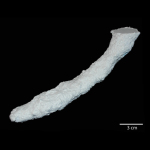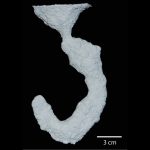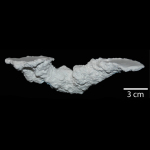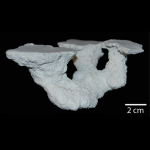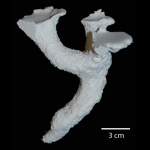Eastern Tiger Salamander (Ambystoma tigrinum)
For full details see Dzenowski and Hembree (2014) in Experimental Approaches to Understanding Fossil Behavior (Topics in Geobiology, Springer)
Description of Organism
- One of the largest species of ambystomatid salamanders; adults reach lengths of 15-25cm
- Wide geographic range in eastern North America, extending from the Gulf of Mexico to the Midwest; mostly absent east of the Appalachian mountains
- Inhabit moist soils near streams, ponds, and lakes
- Feed on worms, insects, frogs, and other salamanders
- Live in deep burrows; individuals leave to feed and to mate in the spring
Published Descriptions of Organism
Dzenowski and Hembree (2014):
- Ambystoma tigrinum, the eastern tiger salamander, has a wide geographic range in eastern North America that extends from the Gulf Coastal Plains to the plains of the Midwest, but it is mostly absent east of the Appalachians. It is one of the largest salamander species within the ambystomatids, reaching total adult lengths of 15–25 cm. The life span of A. tigrinum is 12–15 years. Individuals mate in the spring, leaving their burrows to mate and deposit eggs within small ponds or streams. Ambystoma tigrinum actively excavate their burrows through the use of their snout and forelimbs; the hind limbs are used to move loose sediment into mounds.
Burrowing Technique
Ambystoma tigrinum burrows using excavation and compaction techniques. Excavation is used to start the burrow after which compaction is used to expand the burrow in the subsurface. Tiger salamanders excavate by bracing their bodies on the surface with their hind limbs and then thrusting their forelimbs into the sediment; sediment is pulled back into small mounds near the burrow entrance. Once below the surface, the salamander moves its head and body laterally and vertically to compact the sediment around the margins of the burrow.
Burrowing Technique Video
Burrowing Behavior
Tiger salamanders begin to burrow within 12 hours of being placed in experimental enclosures. Salamanders either quickly abandoned their burrows and created new ones or inhabited the same burrow for the duration of the experiments. The burrows were used as temporary shelters to permanent dwellings. The salamanders spent approximately 80% of their time below the surface, emerging at night to feed. New burrow openings were often produced when exiting the burrow.
Trace Morphology
The tiger salamanders produced five distinct burrow architectures: subvertical, J-shaped, U-shaped, W-shaped, and Y-shaped burrows; examples of each are shown below. Each photo is linked to an information page about the specific burrow architecture shown.

